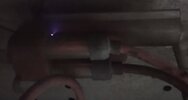As I suspected, it's either a discharge resistor, or a high voltage capacitor - the set would work fine without it, but you've then got the issue of what to do with the wires, how to join them, and how to prevent that join arcing.
I'd be inclined to try and seal the leak, see if you can cure it that way - first job, make sure the CRT is discharged - standard TV engineer way is two screwdrivers. One to the aquadag, then slide the other across that one and underneath the anode cap - that cap should be a single connection, so no problems.
If you remove the cap, then fit a croc clip lead from cap to the aguadag wire/spring to keep that discharged, and do the same with the end of the EHT lead.
The shock from EHT isn't particularly 'dangerous', as it's too low a current - but falling over and breaking your neck as a result is just as fatal.
Then clean the faulty component really well with alcohol, IPA or something similar - then discharge the CRT again (they tend to self recharge - so keep doing so occasionally). I would then grind the offending area away carefully with a Dremel, as the plastic probably has a carbon track burnt in it, and you need to get rid of that - go as deep as required to get rid of it all, without damaging the component inside the plastic.
This should give you a nice clean hole, with good adhesion - fill this with epoxy resin (5 minute epoxy glue), and fill it proud with a nice dome on the outside.
Let it set - I would give it overnight, then you should be good to go.
Incidentally, for anyone else reading this in the future - if you have a similar issue and the device has a control on it, this means that the EHT lead and cap is coaxial, this requires a special tool to remove, which is an SRBP wedge/fork type device that squeezes the outer coaxial connections together to unhook them (we used to have a handful of them sat in a draw at work). Trying to remove it without could damage the cap, and the CRT connection.


